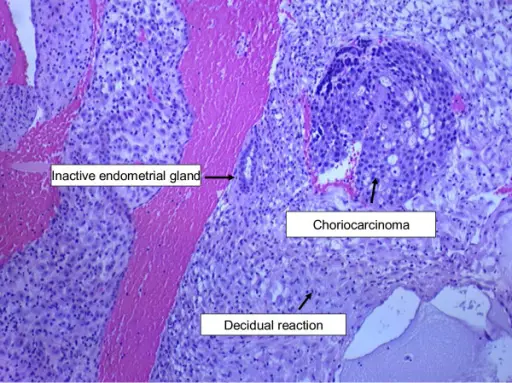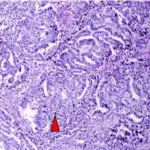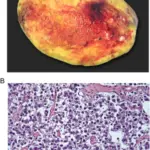Choriocarcinoma of the o.vary is highly malignant ovarian tumor which is characterized by the presence of trophoblastic malignant cells, and the production of the pregnancy hormone human chorionic gonadotrophin hCG in the absence of an ongoing pregnancy.
What is the Pathology of Ovarian Choriocarcinoma?
The pathology of ovarian choriocarcinoma is:
-Etiology: The cause of ovarian choriocarcinoma is hydatidiform mole, spontaneous abortion.
-Genes involved: CSH1 gene.
-Pathogenesis: The sequence of events that lead to ovarian choriocarcinoma is malignant proliferation.
-Morphology: The morphology associated with ovarian choriocarcinoma shows circumscribed hemorrhagic mass, hemorrheage and necrosis and tumor cells resembling placental trophoblastic cell.
-Histology: The histology associated with ovarian choriocarcinoma shows malignant cells.
How does Ovarian Choriocarcinoma Present?
Patients with ovarian choriocarcinoma typically in females at young age. Women over the age of 40 are at increased risk for gestational choriocarcinoma. The symptoms, features, and clinical findings associated with ovarian choriocarcinoma include: lower abdominal pain, atypical genital bleeding, amenorrhea, nausea, and vomiting.
How is Ovarian Choriocarcinoma Diagnosed?
Ovarian choriocarcinoma is diagnosed by: pelvic exam for lumps, blood test for hCG levels, ultrasound, x-ray, CT scan, MRI.
How is Ovarian Choriocarcinoma Treated?
Ovarian choriocarcinoma is treated by: methotrexate-based chemotherapy, total abdominal hysterectomy, bilateral salpingo-oophorectomy, conservative surgery.
What is the Prognosis of Ovarian Choriocarcinoma?
The prognosis of ovarian choriocarcinoma is good. The survival rate is 96.4%. It is important to clarify whether the tumor arose from a gestational or nongestational origin in order to understand the prognosis of this disease accurately.



